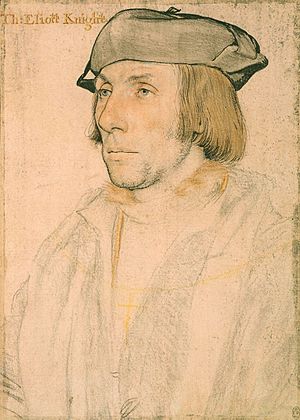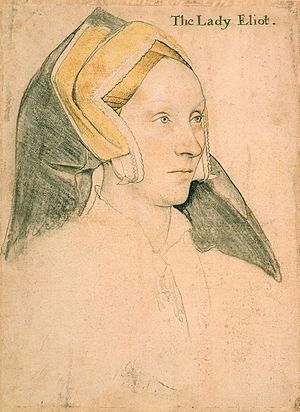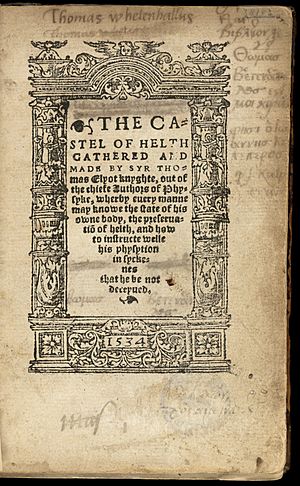Thomas Elyot facts for kids
Quick facts for kids
Thomas Elyot
|
|
|---|---|

Portrait of Sir Thomas Elyot, drawn by Hans Holbein the Younger
|
|
| Born | c. 1496 |
| Died | 26 March 1546 (aged 49–50) |
| Occupation | Author Diplomat |
| Spouse(s) | Margaret à Barrow |
| Parents |
|

Sir Thomas Elyot (born around 1496, died March 26, 1546) was an English diplomat (someone who represents their country in other nations) and a smart scholar. He is famous for being one of the first people to strongly believe that the English language should be used for writing books and stories.
Contents
Early Life and Education
Thomas Elyot was the son of Sir Richard Elyot and Alice De la Mare. We don't know exactly when or where he was born. His mother's first husband died in 1495, so Thomas was born after that.
Some people thought he went to St Mary Hall, Oxford or Jesus College, Cambridge. However, Thomas Elyot himself wrote that he was taught at home. He said that from the age of twelve, he taught himself! He also mentioned that a respected doctor, Thomas Linacre, taught him about philosophy and medicine from ancient writers like Claudius Galen.
Sir Thomas Elyot's Career
Early Public Service
In 1511, Thomas Elyot started working with his father as a clerk (a record keeper) for the assize (a type of court). He held this job until 1528. He also inherited land in Wiltshire, Oxfordshire, and Cambridgeshire.
Cardinal Wolsey, a powerful figure at the time, helped him settle a land dispute. Wolsey also made him a clerk of the Privy Council, which was a group of advisors to the king. Elyot later said he never got paid for this job. He was also made a knight in 1530, but this honor cost him money instead of helping him. In 1527, he became the High Sheriff of Oxfordshire and Berkshire, a royal official in charge of law enforcement in those areas.
Diplomatic Missions
In 1531, King Henry VIII sent Elyot to meet Charles V, Holy Roman Emperor. Henry wanted Charles to agree with his plan to divorce Catherine of Aragon, who was Charles's aunt. Elyot also had another secret mission: to try and arrest William Tyndale, who was translating the Bible into English.
Elyot spent a lot of his own money on these trips. When he returned, he asked to be excused from serving as High Sheriff of Cambridgeshire and Huntingdonshire in 1532 because he was poor.
Later Life and Parliament
Elyot was part of a group that looked into monasteries before they were closed down by the king. However, he didn't get any land or wealth from this. He was good friends with Thomas More, and this friendship might have made it harder for him to get ahead. He wrote to Thomas Cromwell, another powerful advisor, saying that while he valued his friendship with More, his duty to the king came first.
From 1539 to 1542, he was a member of Parliament for the town of Cambridge. He bought land in Cambridgeshire, where he later died.
Private Life
Thomas Elyot married Margaret à Barrow. She was known for being a student in the "school" of Sir Thomas More, meaning she was part of his intellectual circle. They did not have any children.
Sir Thomas Elyot's Writings
Even though he didn't get many rewards from the government, Thomas Elyot was highly respected for his knowledge and his books.
Supporting Women's Education
Elyot believed that women should be educated. He wrote a book called Defence of Good Women, where he supported the idea of learned women. He thought educated wives could be good companions for their husbands and teach their children strong moral values. This was a popular idea among humanists like Thomas More.
The Governour and Other Works
In 1531, he wrote The Boke named the Governour, which he dedicated to King Henry VIII. This book was about moral philosophy and how to educate people who would hold important positions in society. It taught them the right principles to do their jobs well. The book was very popular and used many quotes from ancient writers. Elyot said he was inspired by Erasmus's Institutio Principis Christiani.
Elyot also helped the English language grow by adding many new words through his writing. In 1536, he published The Castel of Helth, a popular book about medicine. He wanted to make scientific medical knowledge available to people who didn't know Greek. Even though some doctors made fun of it, the public loved it, and it was printed many times.
His Latin Dictionary, finished in 1538, was the first complete dictionary of the Latin language. It was later updated and expanded by Thomas Cooper and became the basis for other dictionaries.
Elyot also wrote Image of Governance (1540), which he said was a translation of an ancient Greek text. He claimed he had to finish it from other sources because the original manuscript was taken back.
Select List of Elyot's Books
Here are some of the books Thomas Elyot translated or wrote:
- The Doctrinal of Princes (around 1533), from Isocrates
- Cyprianus, A Swete and Devoute Sermon of Holy Saynt Ciprian of the Mortalitie of Man (1534)
- Rules of a Christian Life (1534), from Pico della Mirandola
- The Education or Bringing up of Children (around 1535), from Plutarch
- Howe one may take Profite of his Enymes (1535), also from Plutarch
He also wrote:
- The Boke named the Governour (1531)
- The Knowledge which maketh a Wise Man and Pasquyll the Playne (1533)
- The Bankette of Sapience (1534), a collection of wise sayings
- The Castel of Helth (1536)
- The Dictionary of syr Thomas Eliot knyght (1538). An updated version came out in 1542.
- The Defence of Good Women (1540), which praised Anne of Cleves by telling the story of Queen Zenobia of Palmyra.
- Preservative agaynste Deth (1545), which included many quotes from early Christian writers.



